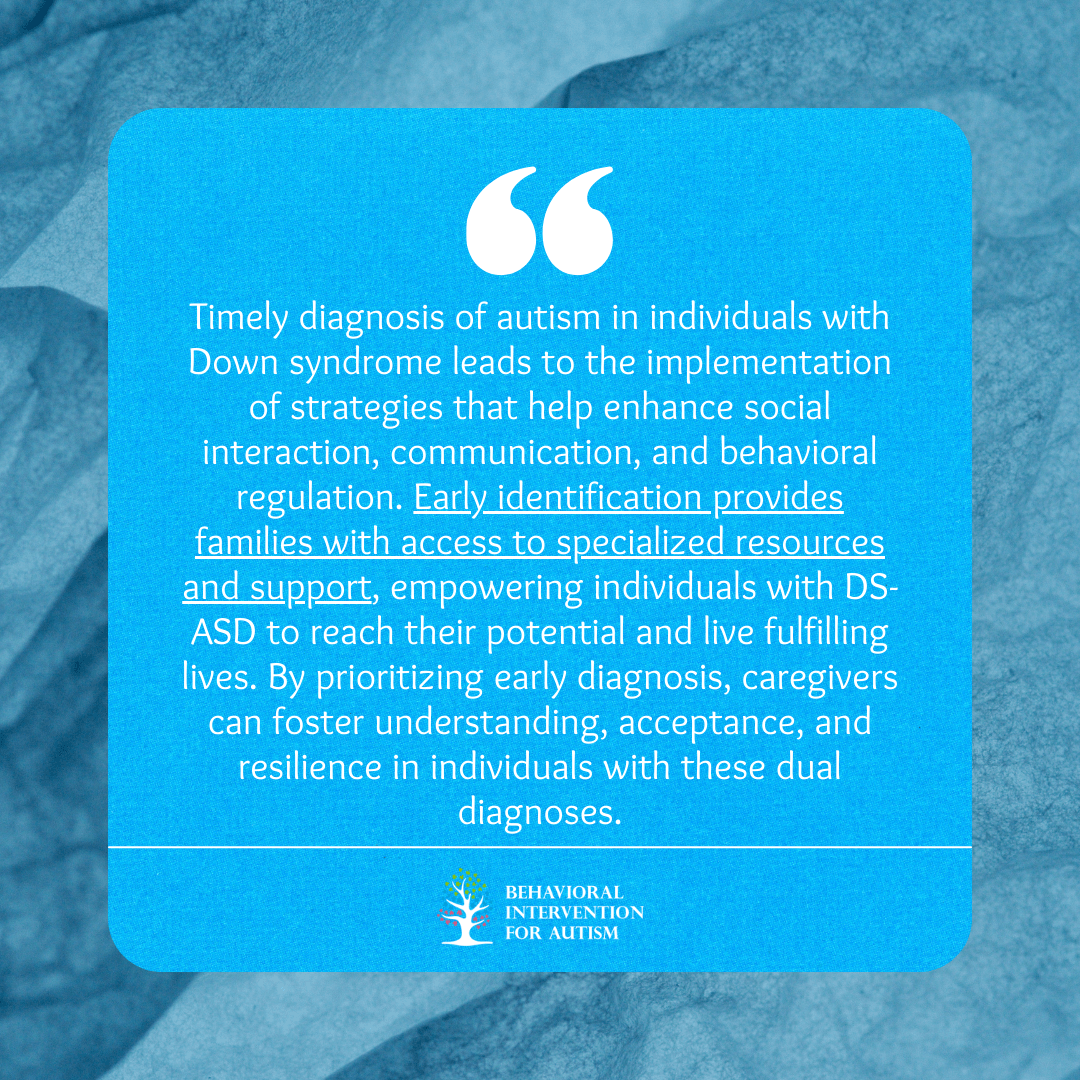
Table of Contents
Understanding the distinctions between autism and Down syndrome is essential for providing optimal care and support. Recognizing both their overlapping characteristics and unique features helps parents and caregivers navigate the complexities of each condition.
Overlapping Characteristics
Individuals with both Down syndrome and autism spectrum disorder (ASD) exhibit a unique blend of characteristics from both conditions, making their presentation more complex. Approximately 16-18% of people with Down syndrome also have ASD, highlighting the need for tailored interventions that address this dual diagnosis.
Autism combined with Down syndrome can bring challenges like social and behavioral difficulties, communication delays, and restricted interests, in addition to the intellectual disabilities and speech delays typical of Down syndrome. Addressing these overlapping features requires a tailored approach to meet their unique developmental needs.
Language development and behavioral patterns differ between those with only Down syndrome and those with both conditions. Individuals with Down syndrome often use gestures, facial expressions, and engage positively during play, while those with DS-ASD may show more significant communication delays and limited nonverbal expressions, necessitating specialized interventions.
Sensory sensitivities and repetitive behaviors are also more pronounced in individuals with DS-ASD compared to those with Down syndrome alone. Understanding these distinctions is essential for creating supportive environments and developing strategies that address both the shared and unique challenges of these conditions.
Differences in Language Development
Understanding the differences in language development between individuals with Down syndrome and autism is essential for tailored support and intervention strategies. Let’s explore the communication patterns in Down syndrome and the language challenges commonly seen in autism.
Communication in Down Syndrome
Individuals with Down syndrome often exhibit effective nonverbal communication skills, utilizing gestures, facial expressions, and body language to express themselves. When autism co-occurs with Down syndrome, language and communication abilities can be more complex.
Language Aspect | Down Syndrome Characteristics |
Verbal Communication | Delayed speech development, tendency to rely on nonverbal cues |
Nonverbal Communication | Strong use of gestures, facial expressions, and body language |
Social Interaction | Generally good social skills, enjoyment of social interactions |
Play Skills | Adequate play skills, ability to engage with others |
Language Challenges in Autism
In contrast, individuals with autism often face significant challenges in language development, particularly in the social use of language and communication. Communication difficulties are a hallmark feature of autism spectrum disorder, impacting verbal and nonverbal interactions.
Language Aspect | Autism Characteristics |
Verbal Communication | Delayed speech development, echolalia, monotonous speech |
Nonverbal Communication | Limited use of gestures, facial expressions, and body language |
Social Interaction | Difficulty with social cues, challenges in initiating and maintaining conversations |
Play Skills | Repetitive behaviors, preference for solitary activities |
For individuals with Down syndrome and autism, effective communication strategies should consider their unique traits and challenges. Tailored support that addresses both language delays and social communication difficulties can enhance the overall quality of life for individuals with these neurodevelopmental conditions.

Behavioral Variances
Understanding the behavioral differences between autism and Down syndrome is vital for providing effective care to neurodiverse individuals. Down syndrome is often associated with a friendly and sociable nature, characterized by affection and an eagerness to connect with others. While some individuals with Down syndrome may display restricted or repetitive behaviors, these are typically less pronounced compared to those seen in autism.
Sensory challenges in individuals with Down syndrome, particularly those without autism, tend to be less intense and disruptive. These sensitivities may cause occasional discomfort but generally result in fewer behavioral challenges compared to the heightened sensory issues common in autism.
In contrast, repetitive behaviors are a core feature of autism spectrum disorder (ASD). Autistic individuals often engage in routines or actions, such as hand-flapping or echolalia, which provide comfort or help them manage sensory input. Sensory sensitivities in autism are more intense and can contribute significantly to behavioral difficulties, requiring tailored interventions.
Recognizing the distinct behavioral traits of Down syndrome and autism enables caregivers and professionals to provide personalized support. By addressing the specific needs of each condition, interventions can enhance the well-being and quality of life for individuals with these neurodiverse conditions.
Sensory Sensitivities
Sensory sensitivities in neurodiverse individuals vary between conditions, with distinct challenges for those with Down syndrome (DS) and autism. While both conditions involve sensory experiences that can impact daily functioning, the intensity and nature of these sensitivities differ. Individuals with Down syndrome may experience sensory sensitivities, such as heightened awareness of certain stimuli like sound, touch, or light. However, these challenges are generally manageable and do not significantly disrupt daily activities.
In contrast, individuals with autism often experience more intense and disruptive sensory sensitivities. These can include both hypersensitivity (heightened sensitivity) and hyposensitivity (reduced sensitivity) across multiple sensory modalities, such as sight, sound, and touch. These sensitivities can lead to behavioral difficulties and challenges in emotional regulation, making them more overwhelming compared to individuals with Down syndrome alone or those with Down syndrome and autism (DS-ASD).
Sensory sensitivities are often more pronounced in individuals with DS-ASD, leading to additional behavioral challenges. Understanding these sensory experiences is crucial for providing effective support. By addressing sensory needs and implementing appropriate strategies, caregivers and professionals can enhance the quality of life and developmental outcomes for individuals with Down syndrome, autism, or both.
Diagnosis and Early Intervention
Early diagnosis and intervention are crucial in managing neurodiversity, particularly for individuals with Down syndrome and autism. Identifying autism in individuals with Down syndrome allows for tailored support and effective management, improving their ability to navigate life’s challenges. Early intervention is key to addressing sensory challenges, behavioral complexities, and communication difficulties that often accompany autism in individuals with Down syndrome.
Children with Down syndrome who also have autism (DS-ASD) tend to exhibit more pronounced sensory and behavioral difficulties compared to those with Down syndrome alone. Parents and caregivers must be vigilant for signs of autism, such as unusual social interactions, communication challenges, and repetitive behaviors. Recognizing these early indicators is essential for initiating appropriate assessments and interventions.
Autism is typically diagnosed through a comprehensive evaluation by specialists, including neuropsychologists or developmental pediatricians. This process involves various tests to assess behavior, communication, and social interaction. An early diagnosis enables tailored interventions that address the unique needs of individuals with DS-ASD, improving their overall development and quality of life.

Resources and Support
Parents and caregivers of individuals with autism and Down syndrome play a crucial role in providing support and resources. Understanding the specific needs of these conditions is essential for fostering a nurturing environment that helps individuals thrive. Here, we will explore ways parents and caregivers can support their loved ones, as well as highlight organizations that offer valuable assistance.
Support for individuals with autism and Down syndrome requires tailored approaches. Parents and caregivers can educate themselves about the characteristics of both conditions, seek support from groups and online communities, and work closely with healthcare professionals to develop personalized care plans. Consistent routines and clear communication strategies are also essential, as is practicing patience and understanding, given the demanding yet rewarding nature of caregiving.
Several organizations provide resources and support to families of individuals with autism and Down syndrome. These organizations offer advocacy, educational resources, and practical tools to help families navigate the challenges of these conditions. Notable organizations include Autism Speaks, the National Down Syndrome Society, the Autism Society of America, and the Down Syndrome Association.
Accessing resources from these organizations allows parents and caregivers to connect with others, gain valuable insights, and receive the support needed to help their loved ones lead fulfilling lives. Their dedication and advocacy are crucial in creating an inclusive, supportive community for individuals with autism and Down syndrome.
Get Personalized Support with ABA Therapy
While both autism and Down syndrome are developmental disorders, they present unique challenges and characteristics. Autism often involves differences in social communication, repetitive behaviors, and sensory sensitivities, while Down syndrome is typically associated with intellectual disabilities and distinct physical traits. Understanding these differences is key for developing effective support strategies. Behavioral Intervention For Autism offers specialized ABA programs in Florida that are designed to address the individual needs of each person with autism. Our experienced team is committed to providing tailored, evidence-based therapy that fosters growth and development. If you’re seeking guidance or support, don’t hesitate to get in touch with us today to learn how we can help!
- 9 Common Obsessions of Children With Autism You Should Know - February 25, 2025
- What is Neurodiversity? A Guide to Embracing Differences - February 25, 2025
- Understanding Hyperfocus in Autism: What It Means and Why It Happens - February 25, 2025
